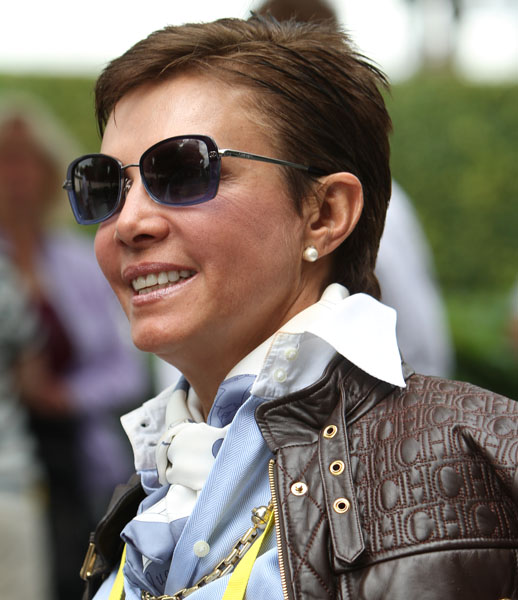Mexican Invasion Launched for Month of Competitions,Training & Development in Wellington
11 years ago StraightArrow Comments Off on Mexican Invasion Launched for Month of Competitions,Training & Development in Wellington

By KENNETH J. BRADDICK
WELLINGTON, Florida, Mar. 9–An invasion of nine horses and five riders from Mexico, the largest number ever at one time, is making the most of a month at the Global Dressage Festival in a major step on a years long effort to develop the sport at the grass roots to international competitiion.
Within days of arriving in Wellington, four combinations were in the arenas at a national show competing at different levels up to Grand Prix in preparation for international events to come, but mostly to train and experience one of the world’s major dressage circuits.
With guidance and training from Gary Rockwell, one of America’s four International Equestrian Federation (FEI) 5* judges, the riders are looking beyond this year’s world championships and the 2015 Pan American Games, an Olymic qualifier that will be at mixed Big and Small Tour instead of small tour that has been the level for the continental championships held once every four years.
Antonio Rivera Galarza and Wizard Banamex at Grand Prix, Mariana Qintana on Benzemá and Lourdes Ariza on Naval Banamex at Prix St. Georges and Nina Jaakkola on Zimbro La Cascada at U.S. Third Level competed in the national competition at the Palm Beach International Equestrian Center’s Stadium complex that stages the dressage shows.
Mariana on Benzemá placed second with 70.263 per cent out of 15 starting combinations in the Prix St. Georges while Antonio and Wizard were third on 66.400 per cent in the Grand Prix.

The unprecedented presence of so many horses and riders from Mexico matches a big influx of combinations in addition to the large numbers of Canadian and United States riders that have made the Global Dressage Festival as a companion event to the Winter Equestrian Festival of jumpers and hunters as the world’s major winter circuit.
This was the first visit for Antonio to Wellington since he competed here almost 20 years ago after training in Germany with the late great George Theodorescu. Then, most of the roads were unpaved and dressage was staged in an available jumping arena during WEF.
He became acquainted with Gary who also was training and competing in Europe at the same time and then met up again in Wellington.
Antonio and other riders started working with Gary to prepare for the Central American Games in Puerto Rico four years ago. Now it has grown to several riders in tandem with expansion of dressage from its initial base in Mexico City to groups in Guadalajara, Monterrey and San Miguel.
Gary works with individuals, mostly in clinics, and is not a part of a program of the Mexican federation.
“We have a good trainer and he helps us develop good riding in Mexico,” Antonio said. .”We have now in Mexico better quality horses and the riders have improved a lot. So we are very happy with what is going on.
“It is not only for the Pan American Games and other shows but for long term training. We need good basics and to focus on the training, not just a particular goal.”

Although the cost of round trip travel from Mexico, a month of stabling at the show grounds, training and show entries as well as accommodations for riders and grooms is high, Antonio said, “it was a moment to come here with better horses and riders, part of building up dressage.”
“You ride better when there are better riders around you,” Gary said. In next week’s Global Dressage Festival World Cup Grand Prix, for example, there are 36 entries.
Plus, the relatively small number of judges in Mexico means they see the same horses much of the time.
“We wanted to get away and get into the CDIs where the judges are not overly familiar with the horses.”
A major factor in development of dressage in Central America has been the efforts of FEI 5* judge Maribel Alonso de Quinzaños of Mexico who was instrumental in creating the new Pan Am dressage format to mixed big and small tour teams from small tour. The move is intended to lead to full Grand Prix squads and retain the championships as an Olympic qualifier.
Her recent appointment to the six-member FEI Dressage Committee was lauded not only in Central and South America but also for her communications skills with other stakeholder groups around the world.
And after years of no international competitions, Mexico will host two CDI3* events in 2014, at Mexico City in May and June, as well as hosting the Caribbean and Central American Games in Veracruz in November.

Antonio said that Mexico is “pretty close” to being able to field a team made up of Grand Prix horses.
In addition to three horses competing or ready to do so at Grand Prix, Olympian Bernadette Pujals is back in Europe while a rider in Sweden has advised he has Mexican citizenship and could seek to ride for the country.
“This is the best Mexico has ever had,” Antonio said. “We are developing in the right direction.”
Mexico could have enough Grand Prix horses by the time of the 2016 Olympics in Rio de Janeiro, Gary said, but qualifying would be difficult. Under new qualifying procedures, only one team will be able to qualify through the Pan Ams in 2015. However, if three individuals are able to qualify from a single nation they could form a composite team.
“It is good to get their feet wet and to see the world,” he said of the experience in Florida.
“The experience will open our minds,” Antonio added.


